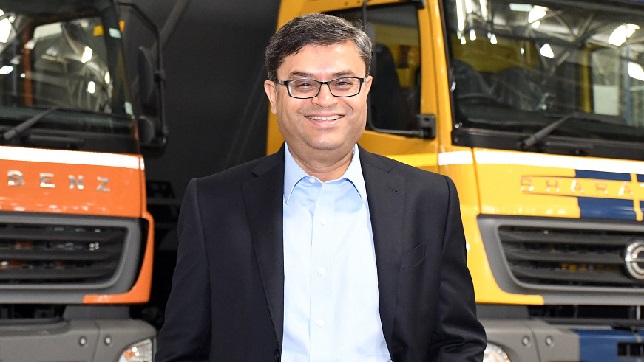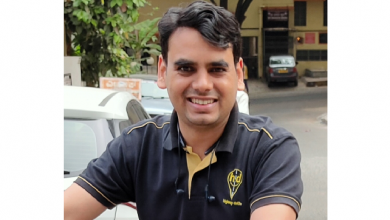India is the manufacturing hub for our global medium-duty transmission

Satyakam Arya shares his views with Telematics Wire on wide-ranging topics from- how automotive industry can recover from the slowdown, DICV being the global hub for medium duty transmission, transition to electric mobility, safety of transport vehicle and more.
In your view, what has been the impact of COVID-19 on Indian automotive industry? How much time will industry and specifically commercial vehicle segment take to recover?
The medium and heavy commercial vehicle industry is going through a tough phase in 2020 due to many reasons including COVID-19. The CV market is closely linked to the economic activity; until this improves, there will be a limited demand for movement of freight. Having said that, the economic stimulus package provided by government helps to bring revival of demand in construction and mining segments. We already see some positive traction in these segments. Further, we see E-commerce segment gaining momentum since people are switching more to on-line buying for essential goods and even for limited discretionary spending due to the pandemic. This will also improve volumes in small and light commercial vehicles due to increased demand for last mile delivery of goods.
Fortunately, DICV is uniquely positioned to weather the crisis in part due to the strong backing of the global Daimler group, but also due to the approximately 90% localization of its supplier network which allows us to be less reliant on international supply chains. Apart from that, we are already strongly positioned in construction and mining segment due to the robustness of our products, and in E-commerce where our products offer the best turnaround time and on-time delivery.
We believe India will recover sooner and better from the crisis than many other economies and growth would start to return in 2021 from the low level of 2020. In the next 2-3 years, the CV industry could return to the market volumes we saw in 2019.
How is Daimler India gearing up to serve Indian as well as global customers in post Covid-19 world dressing the major challenges?
To date, DICV has already exported over 30,000 vehicles to more than 50 markets. Additionally, we’ve put over 1 lakh BharatBenz trucks on Indian roads since we started production less than a decade ago. To ensure this level of success continues both here and abroad, we are focusing on making DICV even more resilient and using the crisis as an opportunity to emerge even stronger when the crisis ends. One of the areas we are focusing on is to further increase our localization levels from the 90% which we had achieved in the past. This will definitely also help us to manage our supply chains better in the Covid scenario.
Our suppliers contribute greatly in exports of parts to other Daimler entities. As of today, we have exported more than 125 million parts. This has given our suppliers an edge in competing globally. In fact, they have also won supplier awards in the Daimler world, thereby proving the quality of Make in India. Another proof is that India is the only manufacturing hub for our GMDT (Global Medium Duty Transmission) production which we ship to Germany. Our global manufacturing processes have been completely re-aligned to not only include Indian operations but also to utilize the competitiveness and capability of India more in the future.
What is Daimler’s ‘Bus Care’ Program? How will it help customers to resume operations post lockdown?
The Daimler ‘Bus Care’ program started in July 2020 and will help customers restart their operations. The program includes a free service campaign with driver training on COVID-19 preventive measures and the distribution of personal hygiene kits, thermometers and disinfectant sprayers. This program has already been executed for over 1400 buses and 1900 drivers in 75 locations.
Do you think government initiative can hasten the market recovery of commercial vehicle sales in India?
The government can hasten market recovery by introducing a well-formulated scrappage policy that takes a long-term view on sustainability.
There are approximately 28 million vehicles that are over 10 year’s old running on Indian roads, causing an excess of pollution. Until older vehicles are taken off the road, pollution will continue to increase at an unacceptable rate. If India takes 50% of BSII and BSIII trucks off the road, we would save about 800 million tonnes of crude oil a year and bring down CO2 levels by 2 million tonnes.
Apart from causing pollution, older vehicles are also a threat to road safety and are less fuel efficient. Although trucks travel at low speeds (average <30 km/hr), they still caused ~25,000 deaths and accounted for ~17% of accident deaths on India’s roads in 2018. Older vehicles with poor maintenance and lesser safety and comfort features are the main reason for this. A clear scrappage policy will reduce accidents and save lives. During times like this, this policy could also trigger fresh demand in case there is a proper incentive for the owner to scrap. Of course, we must make sure there are proper scrap centres established based on principles of recycle and re-use before any such policy is rolled out.
Government can also look at a policy to encourage exports out of India in a much greater way than done today. The Indian automotive industry is quite mature but when it comes to exports, but so far we have only been able to grab a miniscule piece of the global automotive business pie. A policy in that direction which is linked directly to export revenues and is administratively simpler to manage would be a welcome step.
Daimler India has recently made investment of over INR 2,000 crores. What has been the area of investment?
DICV signed a second Memorandum of Understanding with the Government of Tamil Nadu several months ago covering INR 2,277 crore of investments. This investment is directed towards expanding our product portfolio, investment in technology, digitalization and represents approximately 400 jobs.
It demonstrates our unshakeable confidence in the long-term potential of India as a market for commercial vehicles, and our ongoing commitment to the country as a whole.
What are your investment plans in bringing emerging technologies like connected vehicle to Indian Commercial Vehicle market?
DICV already rolled out Daimler’s telematics solution ‘Truckonnect’ at the beginning of the year with the new BharatBenz BSVI portfolio. Truckonnect gives owners an unprecedented level of control over their fleet. Based on Daimler’s global platform that already connects over 300,000 trucks worldwide, Truckonnect lets customers remotely monitor all key performance indicators including utilization, fuel & Adblue consumption, fleet health and driver behaviour. Users can access all this information 24/7 through an online analytics dashboard.
Truckonnect is provided as standard in all BharatBenz trucks and allows customers to remotely check and analyse vital vehicle information in real time via the Truckonnect online portal, including vehicle location and health, plus fuel consumption. With this, fleet managers can optimize driver performance, increase fuel efficiency, and reduce downtime. Vehicle owners are also supported by a customer assistance centre available during all hours of the day.
Can you throw some light on steps Daimler India is taking to improve safety and security of goods and passengers in its commercial vehicle?
Our new generation of BharatBenz CVs offers ‘ProfitTechnology+’, a package of technologies and features ensuring industry-leading fuel efficiency, safety, comfort and reliability.
For safety we have many features like a crash-tested cabin, reverse parking assist, and the Driver State Monitoring System which alerts the driver in case they show signs of fatigue, helping them avoid falling asleep at the wheel.
In terms of security, the Truckonnect telematics solution can instantly detect when a vehicle is being driven out of bounds or experiences a sudden drop in fuel levels – that is, when the vehicle or its fuel are being stolen.
What are your views about electric goods transport vehicle? When will it be commercially viable to run them on Indian road?
Daimler Trucks and Buses globally are involved in the development of alternative powertrains. These are an important means of avoiding emissions and becoming less dependent on fossil fuels. Daimler has a clear, future-proof strategy to avoid confusing businesses and consumers with the variety of alternative fuel options available. The way to the fuel of the future leads from fossil-based diesel to BTL (Biomass To Liquid = fuel from biomass) and finally to hydrogen for fuel cell powered vehicles. Being a part of the global network, DICV has access to the knowledge and can adapt these technologies depending on the market requirement.
Daimler already has several electric vehicles in its commercial vehicle line-up around the world and these can be adapted for Indian use once the market is ready with the necessary infrastructure (e.g., charging stations) and government support.
As all the conferences/exhibitions across the globe have gone virtual in the past few months, is it generating business or providing adequate B2B networking?
The pandemic has provided DICV with an unprecedented chance to focus on new ways of connecting with stakeholders. Until now, manufacturing was thought to be a 100% hands-on business. Now we see that it is possible for us to digitalize more processes and tasks than we ever thought possible. We connect with our employees, suppliers, dealers and customers virtually, regularly and comprehensively to manage our value chain.
The opportunity to explore new technologies and ways of thinking (such as work from home, virtual sales meetings and events that involve participants from all across India) has shown us new ways to increase productivity and efficiency with impressive cost savings.
In fact, just a few weeks ago we launched our used vehicle platform ‘BharatBenz Exchange’ with an online press conference and a virtual customer meet broadcast live over our social media channels.
Published in Telematics Wire




